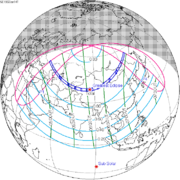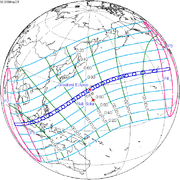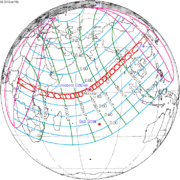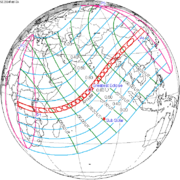| Lists of solar eclipses |
|---|
 |
| Solar eclipses in antiquity |
| Solar eclipses in the Middle Ages |
| Modern history |
| The future |
| Eclipses seen from |
| See also Lists of lunar eclipses |
This list of solar eclipse visible from the Philippines enumerates the solar eclipse that have been and will be seen over the Philippines.
Contents
- Nineteenth century
- Twentieth century
- Total solar eclipses
- Annular solar eclipses
- Partial solar eclipses
- Twenty-first century
- Total solar eclipses 2
- Annular solar eclipses 2
- Partial solar eclipses 2
- Twenty-second century
- References
- External Sources
A solar eclipse occurs when the Moon passes between Earth and the Sun, thereby obscuring Earth's view of the Sun. Eclipses can be total, annular, or partial.
A total solar eclipse occurs when the Moon's apparent diameter is larger than the Sun's, blocking all direct sunlight, turning day into darkness for a brief moment in time. While an annular solar eclipse occurs when the Moon's apparent diameter is smaller than the Sun's, blocking most of the Sun's light and causing the Sun to look like an annulus (ring). These central eclipses occurs only in a narrow path across Earth's surface. A partial solar eclipse, on the other hand, is visible over a surrounding region thousands of kilometres wide in areas where the non-central shadow falls.
Southeast Asia gets a moderate number solar eclipse events, however not every country will get to experience the same type of eclipse since the path of totality is only thin compared to the vastness of earth's surface. For example, a total solar eclipse from Indonesia may only appear as partial from the Philippines if the path of totality misses the archipelago.
Due to its location and relatively small size, a view of totality within the Philippines is a rare experience. There are only 7 recorded events from the 20th century in which the central path of solar eclipse crosses the official territory [1] and predictions suggest that the frequency of occurrence will be the close to that amount for the 21st century. [2]




































































































